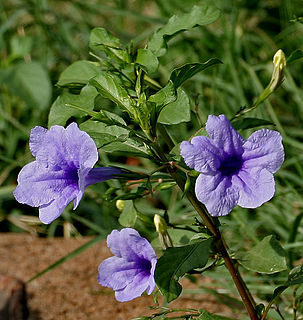Related Research Articles

Acanthaceae is a family of dicotyledonous flowering plants containing almost 250 genera and about 2500 species. Most are tropical herbs, shrubs, or twining vines; some are epiphytes. Only a few species are distributed in temperate regions. The four main centres of distribution are Indonesia and Malaysia, Africa, Brazil, and Central America. Representatives of the family can be found in nearly every habitat, including dense or open forests, scrublands, wet fields and valleys, sea coast and marine areas, swamps, and mangrove forests.

Ruellia is a genus of flowering plants commonly known as ruellias or wild petunias. They are not closely related to petunias (Petunia) although both genera belong to the same euasterid clade. The genus was named in honor of Jean Ruelle, herbalist and physician to Francis I of France and translator of several works of Dioscorides.

Dicliptera is a genus of flowering plants in the bear's breeches family, Acanthaceae. Well-known synonyms include Peristrophe and Dactylostegium.
Monechma is a genus of plants in the family Acanthaceae, closely related to the genus Justicia.

Acanthoideae is a subfamily of plants in the family Acanthaceae.
References
- ↑ Butler, Rhett A. (1 July 2019). "Total number of plant species by country". Mongabay. Retrieved 21 July 2019.
- ↑ "Vegetation of South Africa". PlantZAfrica.com. SA National Biodiversity Institute. Retrieved 24 July 2019.
- 1 2 3 4 5 6 7 8 9 10 11 12 13 14 15 16 17 18 19 20 21 22 23 24 25 26 27 28 29 30 31 32 33 34 35 36 37 38 39 40 41 42 43 44 45 46 47 48 49 50 51 52 53 54 55 56 57 58 59 60 61 62 63 64 65 66 67 68 "species_checklist_20180710.csv". South African National Biodiversity Institute. Retrieved 27 September 2020.